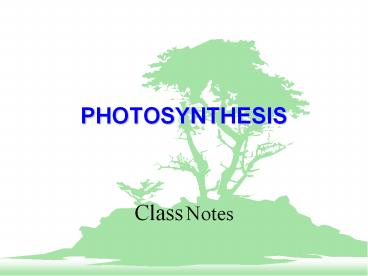PHOTOSYNTHESIS - PowerPoint PPT Presentation
Title:
PHOTOSYNTHESIS
Description:
Class Notes PHOTOSYNTHESIS Photosynthesis is ability of a plant to turn sunlight, air, and water into sugar (energy). The overall reaction is ... – PowerPoint PPT presentation
Number of Views:235
Avg rating:3.0/5.0
Title: PHOTOSYNTHESIS
1
PHOTOSYNTHESIS
Class Notes
2
PHOTOSYNTHESIS
- Photosynthesis is ability of a plant to turn
sunlight, air, and water into sugar (energy). - The overall reaction is
light
chlorophyll
CO2 H2O -------gt CH2O O2 - Photosynthesis is vital to life for two reasons
3
- 1. The oxygen in the air comes from
- photosynthesis. The plants continue to
- replenish the oxygen in the air.
- 2. All of our food comes directly or
- indirectly from photosynthesis.
4
Parts of a leaf
Stomata palisade layer spongy layer veins chloropl
ast thylakoids grana stroma
5
(No Transcript)
6
The Chloroplast -double membrane, stroma,
thylakoid, grana
7
Light
- Photosynthesis uses visible light.
- Only visible light with intermediate wavelengths
has enough energy to cause chemical change
without destroying biological molecules. - What are the colors of the visible spectrum?
- Why does a leaf look green?
8
(No Transcript)
9
- Light is captured by pigments. The main
photosynthetic pigment is chlorophyll. There is
chlorophyll a, b and c. Chlorophyll a is the
major photosynthetic pigment and is found in all
photosynthetic plants, protist, and cyanobacteria
.
10
(No Transcript)
11
Carotenoids
- Carotenoids are accessory pigments found in all
green plants. They absorb blue and green
wavelengths and give a plant a yellow or orange
color. In the fall when chlorophyll breaks down,
it is the accessory pigments which give colors of
fall. The red color of some autumn leaves is due
to the anthocyanin pigments. These are not
photosynthetic.
12
Stages of Photosynthesis
13
The Energy-Capturing Reactions
- Light absorption
- Chlorophyll a and b are antennae pigments
- Electron transport
- Electrons lost by chlorophyll a end up at NADP
- Produce oxygen
- Chemiosmotic ATP synthesis
- Powered by H ion reservoir
14
(No Transcript)
15
(No Transcript)
16
- The Dark reactions use more ATP then NADPH.
- Each turn of the cycle uses 9 ATP and only 6
NADPH. - How are more ATP acquired than NAPH since one ATP
is produced in photosystem II and one NADPH is
produced in photosystem I? - Cyclic and noncyclic electron flow
17
Noncyclic Electron Flow
18
Cyclic Electron Flow
19
The Dark Reactions
- The dark reactions take place outside the
thylakoid membrane in the stroma. The Calvin
Cycle converts CO2 to sugar in a three phase
process. - Carbon fixation - The carbon dioxide is
incorporated into an organic molecule (1C 5C
6C) called RuBP by the enzyme Rubisco. This 6
carbon structure is unstable and immediately
splits into 2, 3 carbon molecules. This is the
same molecule that glucose is split into.
20
- Reduction Each 3 carbon molecule is
phosphorylated by ATP and NAPH to create G3P. The
cycle must turn 3 times for a net gain of one
molecule of G3P. - Regeneration of CO2 acceptor The rearrangement
of 5 molecules of G3P into 3 molecules of RuBP
required 3 more ATP. - ( 9 ATP and 6 NADPH yields 1 G3P)
21
(No Transcript)
22
(No Transcript)
23
(No Transcript)
24
(No Transcript)
25
(No Transcript)
26
(No Transcript)
27
What controls photosynthesis?
- Intensity of light
- Scarcity of water
28
Ecological Aspects
- C4 PLANTS - Use more ATP but at high temperatures
they can photosynthesize faster -allowing plants
to grow and reproduce faster. These include many
weeds and important crops such as corn.
- A special variation of C4 plants are the CAM
plants. These are mostly desert plants. These
plants keep the stomata closed during the day and
open at night. They must conserve water!
29
Vocabulary
- Glossary of terms
- blade
- stipules
- petiole
- vein
- midrib
30
Vocabulary
NADP NADPH photon photosystem photosystem
I photosystem II pigment stroma thylakoid
carotenoids chlorophyll electromagnetic
spectrum granum































